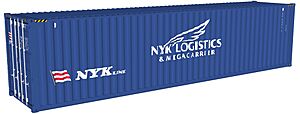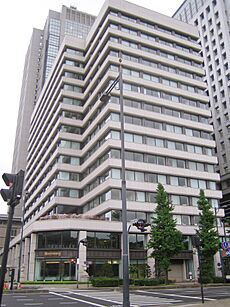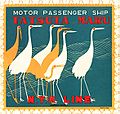Nippon Yusen facts for kids
 |
|

Headquarters in Marunouchi, Chiyoda, Tokyo
|
|
|
Native name
|
日本郵船株式会社
|
|---|---|
| Public K.K. | |
| Traded as | TYO: 9101 NSE: 9101 Nikkei 225 Component |
| Industry | Transportation |
| Founded | September 29, 1885 |
| Headquarters | Marunouchi, Chiyoda, Tokyo, Japan |
|
Key people
|
Tadaaki Naito (Chairman, Director) Hitoshi Nagasawa (President) |
| Products |
|
| Revenue | |
|
Number of employees
|
35,711 (as of March 31, 2019) |

Nippon Yusen Kabushiki Kaisha, usually called NYK Line, is a very old and large Japanese shipping company. Its main office is in Chiyoda, Tokyo, Japan. NYK Line has a huge fleet of over 800 ships! These ships carry all sorts of things, like container ships (big boxes), tankers (liquids like oil), bulk carriers (loose stuff like grain), and even roll-on/roll-off car carriers (for cars). They also have special ships for woodchips, refrigerated goods, and LNG carriers (for natural gas). NYK Line is also part of the Ocean Network Express and the Mitsubishi Group.
Contents
The Story of NYK Line
Starting Big: 1870-1900
The story of NYK Line began in 1870 with a shipping company called Tsukumo Shokai. This company was started by the Tosa clan. In 1875, it changed its name to Mitsubishi Shokai. That same year, it launched Japan's very first passenger liner service, sailing from Yokohama to Shanghai. Soon after, the company became the Mitsubishi Mail Steamship Company.
In 1885, this company joined with another one called Kyodo Unyu Kaisha. This merger created the company we know today: Nippon Yusen Kabushiki Kaisha. The new company started with 58 steamships. It quickly grew its services, first to other Asian ports, and then all over the world. By 1896, NYK Line had a service to Seattle, and by 1899, ships were sailing to London.
NYK Line even helped Chinese Muslims travel for their Hajj (pilgrimage to Makkah) in 1925. Their ship, the Katori Maru, took them to Singapore. From there, other NYK ships took them to Suez, closer to Makkah. The company helped with all the travel details and even offered pilgrims a 20% discount on tickets.
Growing Strong: 1900-1945
During this time, most Japanese merchant ships, tankers, and liners were part of the NYK fleet. They had regular services connecting Kobe and Yokohama to places like South America, Batavia, Melbourne, and Cape Town. There were also frequent trips to San Francisco and Seattle.
Ships traveled east from Japan to Vancouver (Canada) or Seattle. Some routes stopped in Hawaii before continuing to San Francisco and through the Panama Canal. Other routes went south from Japan, across the East China Sea, to Southeast Asia, India, and even to Europe or Australia. The fastest trips from Yokohama to Seattle took only 10 days, and to Europe, about a month.
NYK Line also connected many local Japanese ports. Important ports like Yokohama, Kobe, and Osaka were key for trade. Ships carried coal from Moji to Osaka and Yokohama. Timber from Karafuto and Soybean products from Dairen were also big parts of their local trade. In 1926, another shipping company, Toyo Kisen Line, joined NYK.
From 1924, all new cargo ships for NYK were motor ships, which use engines instead of steam. NYK started using passenger motor ships in 1929.
World War II and Its Impact
During World War II, NYK Line's ships were used to transport soldiers and supplies for the Japanese military. Many of their ships were sunk by the Allied navies. Ports and facilities were also attacked from the air. Sadly, only 37 NYK ships survived the war. The company lost 185 ships helping with military operations. Before the war, NYK had 36 passenger ships, but only one, the Hikawa Maru, remained after the war.
After the war, the winning countries took many of NYK's remaining ships and equipment. The Hikawa Maru was used to bring Japanese soldiers and civilians back home from areas that had been freed from Japanese control.
Famous Ships of the Past (until 1945)
NYK's fleet grew a lot over time. Many ships were named in groups. Some were named after Shinto shrines, others after old provinces of Japan, cities of Japan, mountains, or islands in Japan. Some even had non-Japanese city names.
- Shrine Names: Chichibu Maru, Hie Maru, Heian Maru, Hikawa Maru, Kasuga Maru, Kitano Maru, Nitta Maru, Tatsuta Maru, Terukuni Maru, Yawata Maru
- Province Names: Awa Maru (1899), Awa Maru (1943), Kaga Maru, Noto Maru, Tango Maru
- Mountain Names: Asama Maru, Maya Maru, Rokko Maru
- City Names: Asuka Maru, Calcutta Maru, Dakar Maru, Durban Maru, Hakone Maru, Lima Maru, Lisbon Maru, Lyons Maru
- Other Names: Korea Maru, Kyushu Maru, Rosetta Maru, Siberia Maru, Taiyo Maru, Toyama Maru, Yoshida Maru
Modern Fleet: After the War
By the mid-1950s, NYK ships were once again sailing all over the world. As fewer people traveled by passenger ship in the 1960s, NYK focused more on carrying cargo. They launched Japan's first container ship, the Hakone Maru, on a route to California in 1968. Soon, they had container ship routes to many other ports.
NYK also got involved in air cargo and even train services in the United States. In 1989, NYK started its passenger ship business again with cruise ships through a new company called Crystal Cruises. In 1990, NYK launched its own cruise ship, MS Asuka, for the Japanese market. Later, in 2006, a larger ship, Asuka II, took its place.
By 2008, the NYK Group operated about 776 large ocean vessels, plus planes, trains, and trucks. Their shipping fleet included many types of ships: about 155 containerships, 286 bulk carriers, 113 car carriers, and many more. NYK has offices in 240 places in 27 countries. They also have warehouses and harbor operations around the world.
NYK Line became one of the top shipping companies in the early 2000s. They were a leader in carrying containers and cars. They also received awards for their excellent cruise services.
In 2014, NYK ordered ten new, very large container ships. These ships, named after bird species (like mv NYK Blue Jay), are the largest container ships ever built in Japan. They can carry over 14,000 containers!
In 2021, NYK Line became the first Japanese shipping company to join the Sustainable Shipping Initiative. This initiative promotes safe and environmentally friendly ship recycling.
On November 19, 2023, one of NYK's ships, the Galaxy Leader, was taken over by the Houthi group in the Red Sea. They claimed it was an Israeli-owned ship. In May 2024, the ship's owners asked for the crew to be released.
Modern Ship Names
Today, NYK's ships have many different names. Some are named after flowers, stars, star constellations, and old provinces of Japan.
- Flowers: ACX Cherry, ACX Hibiscus, ACX Jasmine, ACX Lily, ACX Magnolia, ACX Marguerite, ACX Salvia, Plumeria Leader
- Stars: Altair Leader, NYK Altair, NYK Canopus, NYK Deneb, NYK Rigel, NYK Sirius, NYK Vega, Rigel Leader
- Constellations: Andromeda Leader, Aphrodite Leader, Apollon Leader, Aries Leader, Auriga Leader, Cepheus Leader, Cetus Leader, Equuleus Leader, NYK Antares, NYK Leo, NYK Orion, NYK Pegasus, NYK Phoenix, NYK Virgo, Volans Leader
- Provinces: Iga Maru, Izu Maru, Izumo Maru, Kaga Maru (1988), Sanuki Maru, Settsu Maru, Shima Maru
- Other Names: Asama Maru (1954), Astoria Maru, Galaxy Leader, Hakone Maru (1968), Hikawa Maru (1974), Zeus Leader
Joining Forces: Container Operations Merge
On October 31, 2016, NYK Line, along with two other big Japanese shipping companies (Kawasaki Kisen Kaisha and Mitsui OSK Lines), decided to combine their container shipping businesses. They created a brand new company called "Ocean Network Express" (ONE). This new company started operating on April 1, 2018. ONE has its main office in Japan, a global operations center in Singapore, and regional offices around the world.
NYK's Container Ships
NYK Line has several classes of container ships, many of which are now operated by Ocean Network Express.
| Ship class | Built | Capacity (TEU) | Ships in class | Notes |
|---|---|---|---|---|
| NYK Vega-class | 2006–2007 | 9,012 | 4 | Operated by Ocean Network Express |
| NYK Oceanus-class | 2007–2008 | 8,628–9,040 | 4 | Operated by Ocean Network Express |
| NYK Adonis-class | 2010–2011 | 9,592 | 3 | Operated by Ocean Network Express |
| NYK Bird-class | 2016–2019 | 14,000 | 15 | Operated by Ocean Network Express |
Carrying Cars: Roll-on/Roll-off Ships
NYK is the world's largest carrier of roll-on/roll-off (RORO) cargo. RORO ships are special because vehicles can be driven directly onto and off the ship. NYK's RORO fleet can carry about 660,000 cars! This is over 17% of all the car-carrying capacity in the world.
More than 123 NYK RORO vessels sail globally, transporting new cars from Japan, the US, and Europe to Asia, the Middle East, North and South America, Australia, Africa, and Europe. Besides cars, these ships also carry large and heavy items like excavators, cranes, trucks, buses, and trailers.
Images for kids
See also
 In Spanish: NYK Line para niños
In Spanish: NYK Line para niños
- Hikawa Maru-class ocean liner
- New Carissa
- Terukuni Maru-class ocean liner
- John Wilson












































